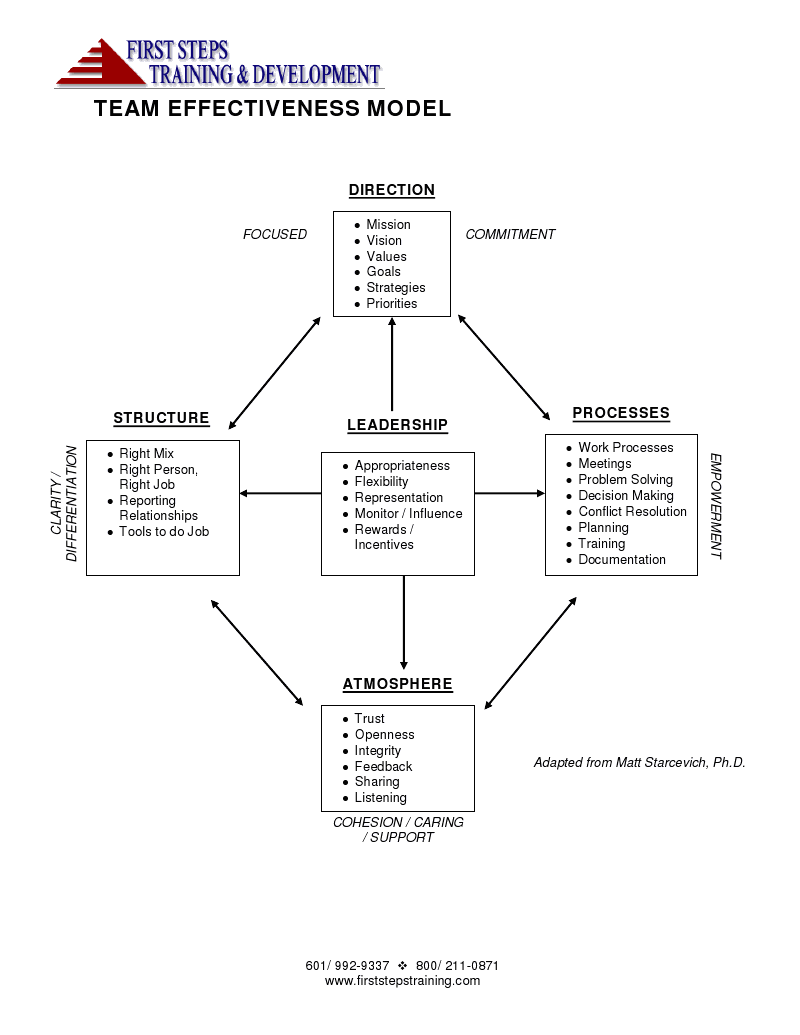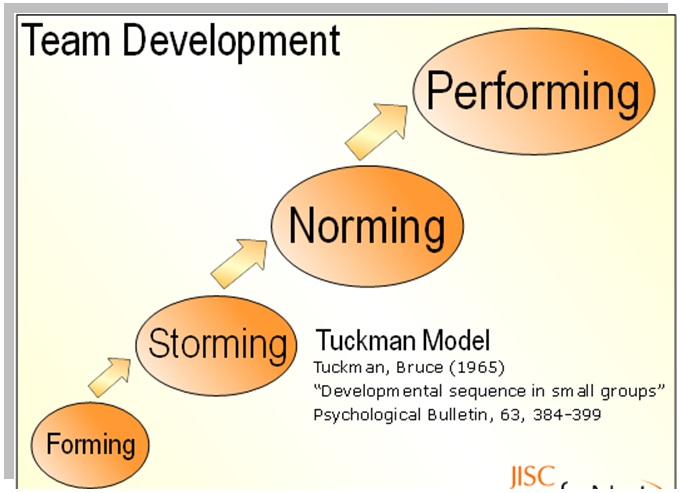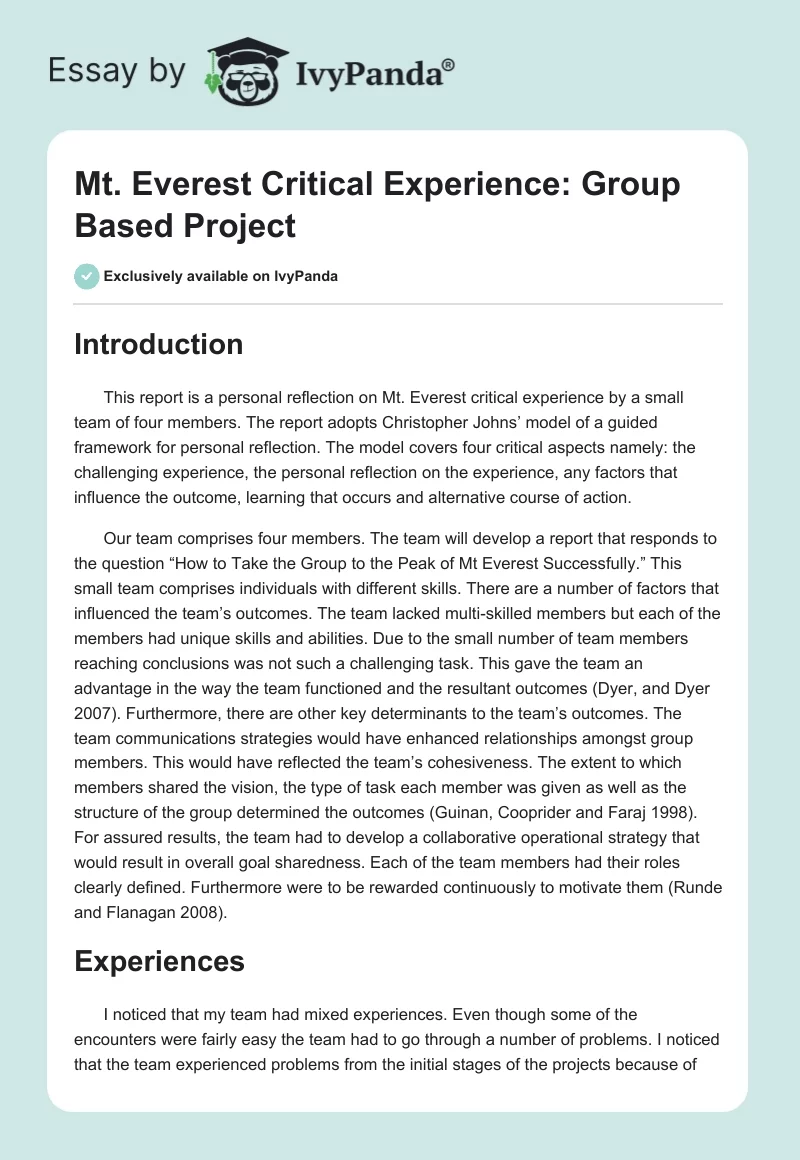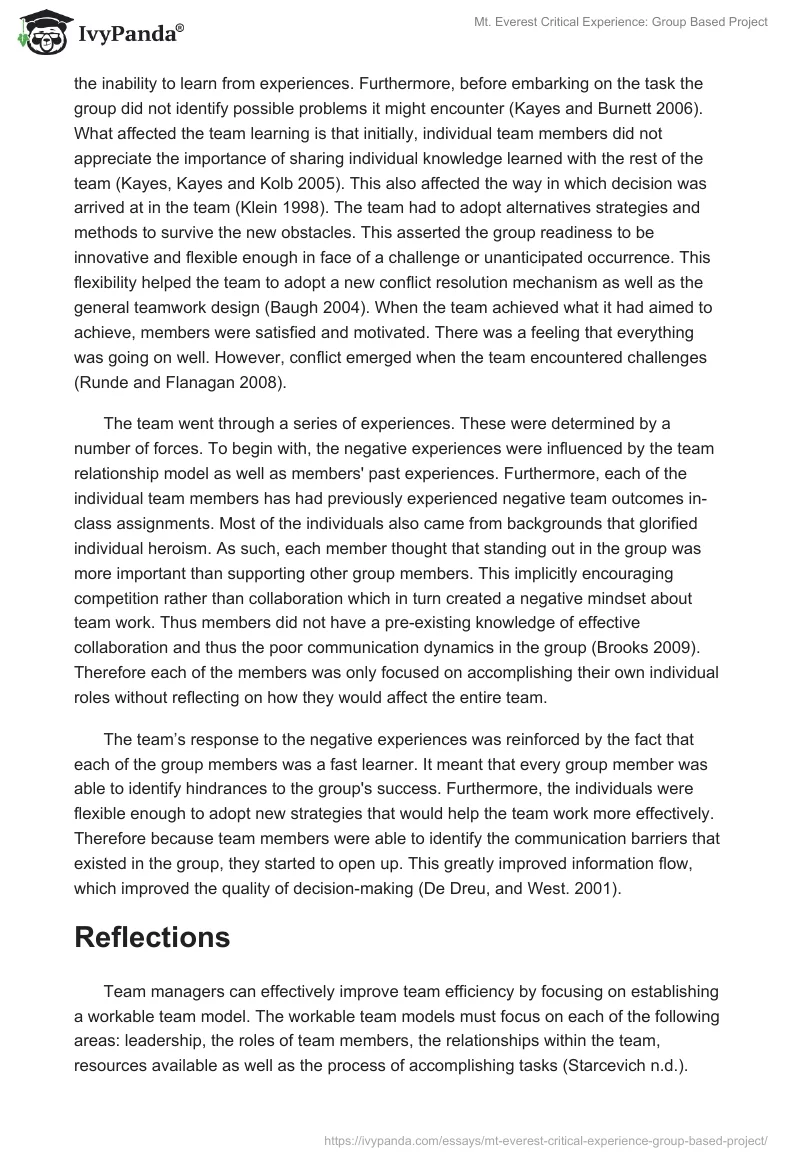Introduction
This report is a personal reflection on Mt. Everest critical experience by a small team of four members. The report adopts Christopher Johns’ model of a guided framework for personal reflection. The model covers four critical aspects namely: the challenging experience, the personal reflection on the experience, any factors that influence the outcome, learning that occurs and alternative course of action.
Our team comprises four members. The team will develop a report that responds to the question “How to Take the Group to the Peak of Mt Everest Successfully.” This small team comprises individuals with different skills. There are a number of factors that influenced the team’s outcomes. The team lacked multi-skilled members but each of the members had unique skills and abilities. Due to the small number of team members reaching conclusions was not such a challenging task. This gave the team an advantage in the way the team functioned and the resultant outcomes (Dyer, and Dyer 2007). Furthermore, there are other key determinants to the team’s outcomes. The team communications strategies would have enhanced relationships amongst group members. This would have reflected the team’s cohesiveness. The extent to which members shared the vision, the type of task each member was given as well as the structure of the group determined the outcomes (Guinan, Cooprider and Faraj 1998). For assured results, the team had to develop a collaborative operational strategy that would result in overall goal sharedness. Each of the team members had their roles clearly defined. Furthermore were to be rewarded continuously to motivate them (Runde and Flanagan 2008).
Experiences
I noticed that my team had mixed experiences. Even though some of the encounters were fairly easy the team had to go through a number of problems. I noticed that the team experienced problems from the initial stages of the projects because of the inability to learn from experiences. Furthermore, before embarking on the task the group did not identify possible problems it might encounter (Kayes and Burnett 2006). What affected the team learning is that initially, individual team members did not appreciate the importance of sharing individual knowledge learned with the rest of the team (Kayes, Kayes and Kolb 2005). This also affected the way in which decision was arrived at in the team (Klein 1998). The team had to adopt alternatives strategies and methods to survive the new obstacles. This asserted the group readiness to be innovative and flexible enough in face of a challenge or unanticipated occurrence. This flexibility helped the team to adopt a new conflict resolution mechanism as well as the general teamwork design (Baugh 2004). When the team achieved what it had aimed to achieve, members were satisfied and motivated. There was a feeling that everything was going on well. However, conflict emerged when the team encountered challenges (Runde and Flanagan 2008).
The team went through a series of experiences. These were determined by a number of forces. To begin with, the negative experiences were influenced by the team relationship model as well as members’ past experiences. Furthermore, each of the individual team members has had previously experienced negative team outcomes in-class assignments. Most of the individuals also came from backgrounds that glorified individual heroism. As such, each member thought that standing out in the group was more important than supporting other group members. This implicitly encouraging competition rather than collaboration which in turn created a negative mindset about team work. Thus members did not have a pre-existing knowledge of effective collaboration and thus the poor communication dynamics in the group (Brooks 2009). Therefore each of the members was only focused on accomplishing their own individual roles without reflecting on how they would affect the entire team.
The team’s response to the negative experiences was reinforced by the fact that each of the group members was a fast learner. It meant that every group member was able to identify hindrances to the group’s success. Furthermore, the individuals were flexible enough to adopt new strategies that would help the team work more effectively. Therefore because team members were able to identify the communication barriers that existed in the group, they started to open up. This greatly improved information flow, which improved the quality of decision-making (De Dreu, and West. 2001).
Reflections
Team managers can effectively improve team efficiency by focusing on establishing a workable team model. The workable team models must focus on each of the following areas: leadership, the roles of team members, the relationships within the team, resources available as well as the process of accomplishing tasks (Starcevich n.d.). Team roles were allocated according to a person’s ability and preference. As such my team roles as a strategist and harmonizer were allocated to me because of my critical thinking as well as strong logistical abilities. This position involved harmonizing all team activities for a shared outcome (Pitts, Graves, and Finney 1995). Is also involved in strategizing upon consideration of emerging challenges. For effective performance, I had to incorporate every member’s skills and opinions in arriving at decisions. From time to time I was asked to give an evaluation of the team’s achievement as well as the gains made or not made. This means that I had to ensure that the team goals and objectives were achieved within the given time as well as lead the team in searching for and adopting new strategies for success in case of unanticipated challenge (Belbin 2010a). Therefore I had to establish essential cooperation among group members and ensure that communication was not hindered by the poor flow of information (Levi 2011). The figure below shows how an effective team model combines team functions

Because my role also involved allocating roles as they arose, I had to acquire reliable information and quality data about individual team member’s skills, abilities, and competencies. Furthermore, I gave members the opportunity to choose the individual roles they would be comfortable with. This was to enhance individual satisfaction with the group task as well as ensure the creation of a formidable team that was able to utilize its human resources well I also had to ensure that each member clearly understood the team roles as well as their functional roles (Levi 2011).. I had to ensure that individual roles did not obscure the shared group vision. Each member thus had to understand that the functional role each of them was playing was for the sake of the group. Whenever members were stuck in their functional roles assigned to them, I encouraged others to contribute and help that the member overcome the obstacle (Belbin 2010b).
As stated earlier this role had been given to me by other group members based on a number of factors. I am relatively liberal-minded which means that I have the ability to consider other people’s opinions before arriving at any decision. Furthermore, I am a critical thinker who takes time to arrive at a critical decision. My critical mind helped me to identify any flow in any opinion or strategy. I thus was able to summarize various situations into a concrete decision’ (Belbin 2010b).
To achieve group objectives the group had to consider a number of external factors. Time was the most crucial of these factors. Members had to make sure that they were time-conscious in executing their function roles so as not to affect the entire group’s achievement. Moreover, knowledge sharing and the flow of information had to be effective. Members had to use short clear statements in expressing their views. If any member did not understand anything they had the opportunity to seek clarification (Belbin 2010b). To avoid the conflict and the challenges that the team faced, the team should have focused on following the Tuckman Team Model. This model gives four sequential stages that a normal team follows before it becomes effectively functional. The stages are forming the group, the storming stage that involves thrashing out differences, the norming stage involving negotiation, and the performing stage (Clements and Jones 2008). The figure below describes the Tuckman model

Alternative courses of action
When it comes to dealing with conflict it is important to establish the cause of the conflict and deal with the cause. This means that the problem is dealt with once and for all. Moreover, the earlier conflict was identified the sooner it was solved thus preventing it from generating a fully-fledged problem that might derail the group’s objectives. Suffice to say the group experience both structured and unstructured problems. The unstructured problems presented the group with more challenges than the structured problems. Therefore, members had to take responsibility for identifying any issue they felt would generate a conflict or problem. Furthermore, negotiation became a very practical alternative in dealing with any conflict (Nagel and Sellamna n.d.). This replaced the earlier strategy where the team leaders mediated between conflicting ideas or team members (Asherman and Asherman 2001). As the group strategist, it means that I had to allow a lot more negotiation in redesigning the group strategies.
Furthermore, the management of information had to be improved tremendously (Levi 2011). This meant that there was a need to be an official information disseminator for the group whose primary role was to be the custodian and disseminator of that information. This role was to ensure that information was analyzed and summarized into useable data and also make sure that that information was delivered where it was needed in time. They also had to gather relevant information (Goleman 2000). Furthermore, there was a need to adopt other qualities to enhance my leadership roles. Initially, I was a laid back liberal strategist who let team members gain group have too much way. This delayed decision making. Thus I had to adopt more assertive behavior, especially during critical decision-making. I realized that I should have asked a more direct question, requested more direct answers, and became a little bit more affirmative in the options that the group should have seriously considered. Assertiveness and affirmation needed to be done moderately without being overbearing (Manz and Sims 1981; Goleman, McKee and Boyatzis 2004).
Initially, I felt that as long as members took the task they were comfortable with this was sufficient for emotional satisfaction. However, I should have had an awareness of the team members changing emotional needs and seek ways to satisfy them (Goleman 2000). Strategies that were formed by the group thus should have reflected the member’s emotional needs. As a leader mandated to lead the group towards making strategic decisions I would have listened to the members more keenly, picking the emotions expressed in their statements. This would have ensured that there was attained emotional harmony in the group for the sustained outcome (Salas, Druskat, and Mount 2006)
Lessons learned
Mt Everest’s critical experience has given me valuable insights into how a team works. Through the experiences, I have gained valuable knowledge of team dynamics as well as effective team roles for use in the future. I have learned that strategizing for a team is a complicated affair. It is impossible to have this process without a conflict of opinions arising. Thus it is important to adopt the best conflict resolution mechanism for the group. Negotiation became the best conflict resolution mechanism for any team. This is because when there is an established method for negotiation the team becomes self-sufficient in effectively solving its problem internally (Nagel and Sellamna n.d.). Furthermore, it makes the conflicting most inert to be actively involved in reaching a weighted compromise. As such the decisions reached are always satisfactory to all parties (De Dreu, and Weingart, 2003).
Each of the members was allocated specific roles had and as such lead the team in undertaking that role. So as a strategist, I had to lead the team in evaluating and adopting the best strategies as needs arose. Thus I became a team leader in that respect. Team leadership thus involves having emotional intelligence. This required that is should have been aware of my own emotional needs and how they affected group outcomes. Moreover, I should also have established a way of understanding other team member’s emotional needs. In future group roles, I have to ensure that members are constantly emotionally satisfied. This creates a rich emotional environment for the sustained outcome (Pherwani and Mandell 2003). Furthermore, any role I assume in any team should supplement the team leader’s efforts. If that role I am playing requires me to assume leadership at a certain time, I should adopt various leadership methods according to group needs. In this case, a combination of affiliative, coercive, and participatory methods ensures sustained group outcomes (Goleman 2000).
Other than cohesiveness goal and vision sharedness, the effective team must have a very effective information management mechanism. Teams fail not because of having the wrong information but in the way the right information is managed. Thus in future group leadership roles, I will ensure that the team establishes a mechanism that not only relays the right information where it is needed at the time is needed but also one that gathers and analyses the right information. Furthermore, the team must understand its informational needs ( Galliers and Leidner 2003).
Conclusion
The effectiveness of any teamwork depends on a number of factors. The type of leadership determines the extent of the success the team achieves. Leadership in a team is not just a designation of the identified team leader. Each member of that team becomes a leader by the virtue of the role they are playing for that team. This means that the team depends on every individual to effectively play their roles and understand that their individual contribution has a direct consequence on the group outcomes. Thus cohesiveness, as well as an unhindered information flow, are vital for assured team success. Lastly, emotional cohesiveness ensures that the members gain the emotional security necessary for creating an effective connection amongst successful group members.
List of References
Asherman, I. and , Asherman, S. 2001. Negotiation Sourcebook-Amherst, MA: HRD Press.
Baugh, G.2004. The influence of interpersonal flexibility on work team conflict over time. A dissertation. Submitted to the office of graduate studies of Texas A&M University.
Belbin, R. M. 2010a. Team Roles at Work. Burlington, MA : Butterworth-Heinemann.
Belbin, R. M. 2010b. Management Teams: Why They Succeed Or Fail. Burlington, MA: Butterworth-Heinemann.
Brooks, K. 2009. You Majored In What? Mapping Your Path from Chaos to Career. New York: Penguin Books.
Clements, P and Jones, J. 2008. The Diversity Training Handbook: A Practical Guide London: Kogan Page.
De Dreu, C and Weingart, R. 2003. Task versus relationship conflict, team performance, and team member satisfaction: A meta-analysis.
Journal of Applied Psychology, Vol 88(4), Aug 741-749. Web.
De Dreu, C, West, M. 2001. Minority dissent and team innovation: The importance of participation in decision making. Journal of Applied Psychology, Vol 86(6).
Dyer, W. and Dyer, J. 2007. Team building: proven strategies for improving team performance. San Francisco, CA: Jossey-Bass
Galleries, R. and Leidner, D. 2003. Strategic Information Management: Challenges And Strategies In Team Work. Burlington, MA: Butterworth-Heinemann,
Goleman, D. 2000. Leadership That Get Results. Harvard Business Review. Web.
Goleman, D. , Boyatzis, R. and McKee, A. 2004. Primal Leadership: Learning To Lead With Emotional Intelligence. Massachusetts: Harvard Business School Press.
JISC Infonet n.d. Team development. Web.
Kayes, B., Kayes, C., & Kolb, D. (2005). Experiential learning in teams. Simulation and Gaming, 36(3), 330-354.
Kayes, C. and Burnett, G. 2006. Team Learning in Organizations: A Review and Integration. School of Business. Web.
Klein, G. (1998). Sources of power: How people make decisions. Cambridge, MA: The MIT Press.
Levi, D. 2011. Group Dynamics for Teams. California: Sage.
Mandell, B. and Pherwani, S. 2003. Relationship between Emotional Intelligence and Transformational Leadership Style: A Gender Comparison.
Journal of Business and Psychology. Vol.17, Number 3, 387-404, Web.
Manz, C. and Sims, H. 1980. Self-Management as a Substitute for Leadership: A Social Learning Theory Perspective.The Academy of Management Review. Vol. 5, No. 3. Web.
Nagel, U and Sellamna, N. n.d. Conflicts in Team. Web.
Pitts, S., Graves, K. and Finney, M. 1995. Team tactics: innovative strategies for teaching and learning. Pennsylvania: J. Weston Walch.
Runde, C. E. and Flanagan, T. A. 2008. Building Conflict Competent Teams. san Francisco CA: Jossey-Bass.
Salas, F. , Druskat, V. and Mount, G. 2006. Linking emotional intelligence and performance at work: current research evidence with groups and individuals. New Jersey. Lawrence Erlbaum Associates , Inc.
Starcevich, M. n.d. A MODEL OF AN effective team. Web.


